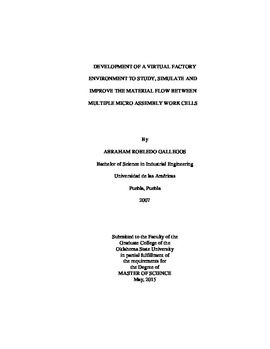| dc.contributor.advisor | Collins, Terry | |
| dc.contributor.author | Robledo Gallegos, Abraham | |
| dc.date.accessioned | 2016-04-15T21:49:38Z | |
| dc.date.available | 2016-04-15T21:49:38Z | |
| dc.date.issued | 2015-05-01 | |
| dc.identifier.uri | https://hdl.handle.net/11244/33449 | |
| dc.description.abstract | This thesis focuses on the creation of a virtual factory environment and its use to improve material flow between micro assembly work cells. The idea is to create a methodology that enables users to study the improvement of micro factory layouts and compare them based on their performance in the virtual environment. The main objectives for this project are to create a virtual factory environment using Unity� software, a game engine, and use it to simulate near optimal routing sequences between work cells. Programming in Unity� creates user interfaces that accept inputs with near optimal sequences that visit all the micro assembly cells in the simulated factory. Near optimal sequences are obtained using genetic algorithms within the Global Optimization tool from MatLab. This tool calls pre - programed functions that repeatedly apply genetic operators, like crossovers and mutations, to a given sequence in order to find a near optimal one. MatLab feeds from external data that consists of the distances between the work cells. These distances are calculated and stored in an Excel file which is read directly from the MatLab environment.All thesis objectives are fulfilled and the proposed methodology is used successfully to create a virtual micro factory in Unity�. The model is used to simulate several sequences for different circumstances:� Material distribution for a twenty four cell layout connected by conveyors.� Material distribution for only twelve of the twenty four available stations.� Design of material distribution sequence to supply twenty four work cells that are not limited by conveyor connections.In all situations the cumulative travel distances calculated in the Unity� model matched the objective function value estimated in MatLab. This validated the ability of the model to accurately represent the motion of materials within a micro assembly factory. This methodology can be used not only to study and improve existing micro factory systems but to also design future micro factories to be more efficient. The flexibility of the Unity� environment enables the users not to only simulate the movement of materials along near optimal sequences but to also reposition objects to quickly create different layout options. | |
| dc.format | application/pdf | |
| dc.language | en_US | |
| dc.publisher | Oklahoma State University | |
| dc.rights | Copyright is held by the author who has granted the Oklahoma State University Library the non-exclusive right to share this material in its institutional repository. Contact Digital Library Services at lib-dls@okstate.edu or 405-744-9161 for the permission policy on the use, reproduction or distribution of this material. | |
| dc.title | Development of a Virtual Factory Environment to Study, Simulate and Improve the Material Flow Between Multiple Micro Assembly Work Cells | |
| dc.type | text | |
| dc.contributor.committeeMember | Deyong, Camille | |
| dc.contributor.committeeMember | Glenn, Jennifer | |
| osu.filename | RobledoGallegos_okstate_0664M_13950.pdf | |
| osu.accesstype | Open Access | |
| dc.description.department | Industrial Engineering & Management | |
| dc.type.genre | Thesis | |
